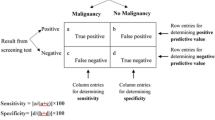Abstract
Objective
The overall risk of malignancy in ovarian neoplasm is 13% in premenopausal women and 45% in postmenopausal women. Differentiating benign and malignant disease with frozen section is possible during operation; however, information on patients’ history, physical examination, paraclinical criteria (tumour markers, imaging) and gross examination of tumour can also be helpful in planing the surgery.
Methods
This study was conducted on 150 women who underwent laparotomy due to adnexal mass between April 2003 and October 2005 at Vali-e-Asr Hospital, Tehran, Iran. Sensitivity and specificity of clinical assessment (history, tumour marker and imaging), gross examination and frozen section were calculated.
Results
Based on our findings frozen section had the highest sensitivity for diagnosing malignant tumour comparing with other methods of diagnosis (88.9%). Sensitivity was 71.3% for preoperative clinical examination, 83% for ultrasonography, 89.8% for CT scan, 70% for CA125 and 84.1% for gross examination, likewise the highest specificity was seen for frozen section (93.5%).
Conclusion
This data confirm that frozen section diagnosis is a reliable method for the surgical management of patients with an ovarian mass, but history of disease, Para clinical criteria and gross examination can help to surgeon to perform on appropriate operation in the areas where frozen section is not possible.



Similar content being viewed by others
References
Scully RE, Young RH, Clement PB (1998) Tumors of the ovary, maldeveloped gonads, fallopian tube, and broad ligament. In: Atlas of tumor pathology. Washington armed forces institute of pathology; fascicle 23, 3rd series
Jemal A, Thomas A, Murray T et al (2002) Cancer statistics. CA cancer J Clin 52:23–47
Koonings PP, Campbell K, Mishell DR Jr, Grimes DA (1989) Relative frequency of primary ovarian neoplasm: a 10-year review. Obstet Gynecol 74:921–926
Disaia PJ, Creasman WT (2004) Clinical Gynecologic Oncology, 5rd edn. St Louis, Mosby, pp 292–324
Nezhat F, Nezhat C, Welander CE (1992) Four ovarian cancers diagnosed during laparoscopic management of 1,011 women with adnexal masses. Am J obstet Gynecol 162:790–796
Shaler E, Eliyahn S, Peleg D, Tasabari A (1994) Laparoscopic management of adnexal cystic masses in post menopausal women. Obstet Gynecol 83:594–596
Stewart, Colin JR, Brennan, Barbara, Hammond, Ian G. Leung, McCartney, Anthony J (2006) Intraoperative assessment of ovarian tumors: a 5-year review with assessment of discrepant diagnostic cases. Int j Gynecol Pathol 25(3):216–222
Dietrich M, Osmers RGW, Zech GG et al (1999) Limitation of the evaluation of adnexal masses by its macroscopic aspects, cytology and biopsy. Eur J Obstet Gynecol 82:57–62
Osmers RGW, Osmer M, Ronmaydell B, Wagner B, Kuhn W (1996) Preoperative evaluation of ovarian tumor in the premenopause by transvaginal sonography. AM J Obstet Gynecol 175(2):428–434
Herrman UJ Jr, Locher GW, Goldhrisch A (1987) Sonographic patterns of ovarian tumors: prediction of malignancy. Obstet Gynecol 69:771–781
Wright JR (1985) The development of the frozen section technique, the evaluation of the surgical biopsy, and the origions of surgical pathology. Bull Hiss Med 59:293–326
Prey M, Vitale T, Martin S (1989) Guidelines for practical utilization of intra operative frozen section. Arch surg 124:331–335
Lehmann Willenbrock E, Mecke H (1993) Pelvic kopische ovarchirurgic- eine retrospeoktive untersuchung ron 1016 operierten zysten. Geburtsh u fraucnheilk 53:253–257
Yeo E, Yu K, Poddar N, Hui P, Tang C (1998) The accuracy of intra operative frozen section in the diagnosis of ovarian tumors. J Obstet Gynecol RES 24:189–195
Obiakor, Maiman M, Mitall K, Awobyluyi M, Diamaio T, Demopoulos R (1991) The accuracy of frozen section in the diagnosis of ovarian neoplasms. Gynecol Oncol 43:61–63
Havrilesky LJ, Peterson BL, Dryden DK (2003) Predictors of clinical outcomes in the laparoscopic management of adnexal masse. Obstet Gynecol 102:243–251
Guello M, Galleguillos G, Zarate C (1999) frozen section biopsy in ovarian neoplasm diagnosis. Diagnosis correlation according to diameter and weight in tumors of epithelial origin. Rev Med Chil 127:1199–1205
Pinto PB, Andrade LA, Derchain SF (2001) Accuracy of intra operative frozen section diagnosis of ovarian tumors. Gynecol Oncol 51:230–232
Souka S, Kamel M, Rocca M, El- Assi M, Hebeishy N, Sheir S (1990) The combined use of cytological imprint and frozen section in the intraoperative diagnosis of ovarian tumors. Int J Gynecol Obstet 31:43–46
Schwartz PE (1991) Ovarian masses: serologic markers. Clin Obstet Gynecol 34:423–432
Author information
Authors and Affiliations
Corresponding author
Rights and permissions
About this article
Cite this article
Ghaemmaghami, F., Fakour, F., Karimi Zarchi, M. et al. Clinical assessment, gross examination, frozen section of ovarian masses: do patients benefit?. Arch Gynecol Obstet 278, 209–213 (2008). https://doi.org/10.1007/s00404-007-0553-8
Received:
Accepted:
Published:
Issue Date:
DOI: https://doi.org/10.1007/s00404-007-0553-8




